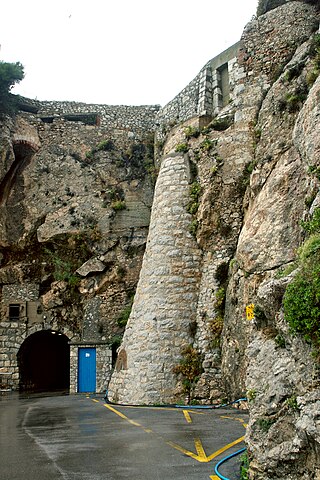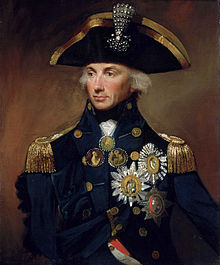
The Rinella Battery was a Victorian battery in Kalkara, Malta. It is commonly referred to as Fort Rinella, although it was never classified as a fort while in use. It was armed with an Armstrong 100-ton gun, which survives; the only other surviving gun is at the Napier of Magdala Battery, Gibraltar.

Royal Navy Dockyards were state-owned harbour facilities where ships of the Royal Navy were built, based, repaired and refitted. Until the mid-19th century the Royal Dockyards were the largest industrial complexes in Britain.

The Commissioners for the Victualling of the Navy, often called the Victualling Commissioners or Victualling Board, was the body responsible under the Navy Board for victualling ships of the British Royal Navy. It oversaw the vast operation of providing naval personnel with enough food, drink and supplies to keep them fighting fit, sometimes for months at a time, in whatever part of the globe they might be stationed. It existed from 1683 until 1832 when its function was first replaced by the Department of the Comptroller of Victualling and Transport Services until 1869 then that office was also abolished and replaced by the Victualling Department.

Gibdock is a shipyard in the British overseas territory of Gibraltar. It formerly operated as a Royal Navy Dockyard.

The 100-ton gun was a 17.72-inch (450 mm) rifled muzzle-loading (RML) gun made by Elswick Ordnance Company, the armaments division of the British manufacturing company Armstrong Whitworth, owned by William Armstrong. The 15 guns Armstrong made were used to arm two Italian battleships and, to counter these, British fortifications at Malta and Gibraltar.

Napier of Magdala Battery is a former coastal artillery battery on the south-western cliffs of the British Overseas Territory of Gibraltar, overlooking the Bay of Gibraltar. It also overlooks Rosia Bay from the north, as does Parson's Lodge Battery from the south. It contains one of two surviving Armstrong 100-ton guns.

The South Mole is a breakwater located in the southern section of Gibraltar Harbour, in the British Overseas Territory of Gibraltar, at the southern end of the Iberian Peninsula. Previously known as the New Mole and New Mole Extension, the South Mole, with the rest of harbour, is just north of the east entrance to the Strait of Gibraltar.

The Detached Mole is a breakwater located at the western aspect of the middle section of Gibraltar Harbour, in the British Overseas Territory of Gibraltar, at the southern end of the Iberian Peninsula. The Detached Mole, with the rest of harbour, is just north of the east entrance to the Strait of Gibraltar and was the site of the Detached Mole Battery. In addition to the role the breakwater plays in the defence of and access to the harbour, the Detached Mole provides berths for ships. The area adjacent to the mole is also a source of recreational and research opportunities, with dive sites at the wrecks of sunken ships.

The North Mole is a breakwater located in the northern section of Gibraltar Harbour, in the British Overseas Territory of Gibraltar, at the southern end of the Iberian Peninsula. The North Mole, with the rest of harbour, is just north of the east entrance to the Strait of Gibraltar. The breakwater was formerly known as the Commercial Mole, and is the site of the commercial port in the harbour. It was the consequence of a late nineteenth century plan by the British Admiralty to create a modern dockyard and large defensive harbour in Gibraltar.

Parson's Lodge Battery is a coastal battery and fort in the British Overseas Territory of Gibraltar.
The Rosia Water Tanks were large water tanks built at the turn of the nineteenth century at Rosia Bay in the British Overseas Territory of Gibraltar. They were constructed based on the recommendation by Admiral John Jervis, 1st Earl of St Vincent that the Victualling Yard complex be relocated to Rosia Bay. The complex allowed Royal Navy vessels to obtain both food and water at one site. The Rosia Water Tanks remained in the possession of the Ministry of Defence until 2004, at which time they were transferred to the Government of Gibraltar. Despite local and international criticism, and a court case brought by the Gibraltar Heritage Trust, the tanks were demolished in 2006 to make way for affordable housing. When developer OEM International's funding proved insufficient to complete the project the government repossessed the site.

The Victualling Yard was a victualling facility in the British Overseas Territory of Gibraltar built for supplying Royal Navy ships while anchored at Rosia Bay.

Streets in the British Overseas Territory of Gibraltar are represented by road signs as in the United Kingdom. As of 2007, Gibraltar has a network of 29 kilometres (18 mi) of roads.

The Gibraltar Heritage Trust is a non-profit charity established by statute on 1 May 1989 to preserve and promote the cultural natural heritage of the British Overseas Territory of Gibraltar.
Camp Bay is a small rocky beach in the British Overseas Territory of Gibraltar. It is located off Rosia Road along the territory's west coast overlooking the Bay of Gibraltar. Parson's Lodge Battery overlooks the northern end of the bay.

Farringdon's Battery is an artillery battery in the British Overseas Territory of Gibraltar. Named after Sir Anthony Farrington, 1st Baronet, it is located above the north face of the Rock of Gibraltar within the Upper Rock Nature Reserve.

Rosia Road is a western road in the British Overseas Territory of Gibraltar. It connects with Boyd Street in the north and flows in a north–south direction, joining Keightley Way in the south. Rosia Road is the site of the Naval dockyard, Nelson's Anchorage the shipyard Gibdock, the headquarters of the Royal Gibraltar Police, Napier of Magdala Battery, Parson's Lodge Battery, the Victualling Yard, and the demolished Rosia Water Tanks.

The Gibraltar peninsula, located at the far southern end of Iberia, has great strategic importance as a result of its position by the Strait of Gibraltar where the Mediterranean Sea meets the Atlantic Ocean. It has repeatedly been contested between European and North African powers and has endured fourteen sieges since it was first settled in the 11th century. The peninsula's occupants – Moors, Spanish, and British – have built successive layers of fortifications and defences including walls, bastions, casemates, gun batteries, magazines, tunnels and galleries. At their peak in 1865, the fortifications housed around 681 guns mounted in 110 batteries and positions, guarding all land and sea approaches to Gibraltar. The fortifications continued to be in military use until as late as the 1970s and by the time tunnelling ceased in the late 1960s, over 34 miles (55 km) of galleries had been dug in an area of only 2.6 square miles (6.7 km2).

Cambridge Battery is a Victorian-era battery in Sliema, Malta. It is commonly referred to as Fort Cambridge, although it was never classified as a fort while in use. It originally contained an Armstrong 100-ton gun.






















